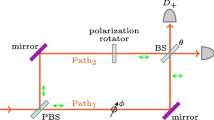In this paper, we re-examine a series of gedanken welcher Weg (WW) experiments introduced by Scully, Englert and Walther that contain the essential ideas underlying the quantum eraser. For this purpose we use the Bohm model which gives a sharp picture of the behaviour of the atoms involved in these experiments. This model supports the thesis that interference disappears in such WW experiments, even though the centre of mass wave function remains coherent throughout the experiment. It also shows exactly what it means to say ‘that the interference can be restored by manipulating the WW detectors long after the atoms have passed’. It does not support Wheeler’s notion that ‘the past is undefined and undefinable without the observation (in the present)’.
Similar content being viewed by others
References
Scully M.O. (1998). “Do Bohm trajectories always provide a trustworthy physical picture of particle motion?”. Phys. Scr. T76, 41–46
Callahan R.E., Hiley B.J. (2006). “Delayed choice experiments and the Bohm approach”. Phys. Scr. 74, 336–348
B. J. Hiley, “Welcher Weg experiments from the Bohm perspective,” in Quantum Theory: Reconsiderations of Foundations-3, G. Adenier, A. Yu. Krennikov, and T. M. Nieuwenhuizen, eds. (AIP, New york, 2006), pp. 154–160.
Bohm D., Hiley B.J. (1987). “An ontological basis for quantum theory: I - particle systems”. Phys. Rep. 144, 323-348
Bohm D., Hiley B.J. (1993). The Undivided Universe: An Ontological Interpretation of Quantum Theory. Routledge, London
Y. Aharonov and L. Vaidman, “About Position Measurements which do not show the Bohmian Particle Position”, in Bohmian Mechanics and Quantum Theory: an Appraisal, J. T. Cushing, A Fine, and S. Goldstein, eds. Boston Studies in the Philosophy of Science, 184, 141–154 (Kluwer Academic, Dordrecht, 1996).
Englert J., Scully M.O., Süssman G., Walther H. (1992). “Surrealistic Bohm trajectories”. Z. Naturforsch. 47a, 1175–1186
Scully M.O., Englert B.G., Walter H. (1991). “Quantum optical tests of complementary”. Nature 351, 111–116
Bohm D., Hiley B.J., Kaloyerou P.N. (1987). “An ontological basis for quantum theory: II - A causal interpretation of quantum fields”. Phys. Rep. 144, 349–375
Holland P.R. (1993). “The de Broglie-Bohm theory of motion and Quantum Field Theory”. Phys. Rep. 224, 95–150
J. A. Wheeler, “The “Past”and the “Delayed-Choice” double-slit experiment”, in Mathematical Foundations of Quantum Theory, A. R. Marlow, ed. (Academic, 1978), pp. 9–48.
Holland P.R. (1993). The Quantum Theory of Motion. Cambridge University Press, Cambridge
N. Erez and M. O. Scully, “Reply to Hiley and Callaghan on the reality/surrealism of the Bohm trajectories”, in Quantum Theory: Reconsideration of Foundations-3, A. Yu. Khrennikov, and Th. M. Nieuwenhuizen, eds. (AIP, New york, 2006), pp. 259–62.
N. Bohr, Atomic Physics and Human Knowledge (Science Editions, New York, 1961).
Author information
Authors and Affiliations
Corresponding author
Rights and permissions
About this article
Cite this article
Hiley, B.J., Callaghan, R.E. What is Erased in the Quantum Erasure?. Found Phys 36, 1869–1883 (2006). https://doi.org/10.1007/s10701-006-9086-4
Received:
Revised:
Published:
Issue Date:
DOI: https://doi.org/10.1007/s10701-006-9086-4




